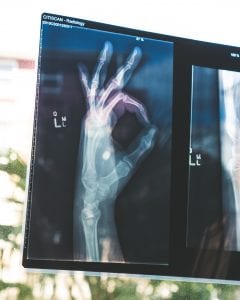AI has helped to improve patient diagnosis rates as well as reduce costs and wasted resources.
Over the last decade, Artificial Intelligence (AI) has been prominent in many industries from automotive and entertainment right through to retail and education. But how does AI differ in the medical sector?
What is Artificial Intelligence?
Firstly, for the few who aren’t familiar with Artificial Intelligence, let me explain what it is and the software used.
Although seen as a relatively new development, the term “artificial intelligence” dates back to the 1950s, first used by researcher John McCarthy.
McCarthy first used this term and defined the key mission of AI as a subfield of computer science. Although artificial intelligence was first thought of back in the 1950s, the concept and development have outgrown what was first imagined and truly shocked scientists by the limitless capabilities.
Artificial intelligence is an area of computer science that uses machine learning techniques to teach computer technology the skills that come naturally to humans. Some of these skills include speech recognition and problem-solving. AI is also sometimes referred to as deep learning and machine learning, although the three things are slightly different.
AI in The Medical Sector
Many healthcare companies of all sizes and specialities, including the NHS, are becoming increasingly interested in how artificial intelligence and deep learning can promote better patient care. AI research within medicine is growing rapidly; in 2016, health care projects attracted more investment than any other sector of the global economy according to the British Journal Of General Practice.
AI in the healthcare industry uses complex algorithms and software to mimic human cognition in the analysis of complex data. What makes AI technology different from traditional technology methods is the ability to gain information, process, and produce a decision output.
Here are just a few of the ways in which AI is currently supporting the needs of the medical industry with the advancements in technology.
Medical Imaging
Medical imaging is the process of creating visual representations of the interior of a human body for clinical and medical analysis. Medical imaging seeks to reveal internal structures hidden by the skin and bones, as well as to diagnose and treat disease.

Unlike other forms of AI within medical imaging, it isn’t just about processing information quickly, it’s about processing data accurately.
In terms of medical imaging, AI has its place to assist health care professionals rather than replace them. AI devices will point out areas of masses that look abnormal for the professionals to then take for further investigation.
The use of AI in medical imaging speeds up the process of analysis and helps to identify areas that require further attention both quickly and accurately.
Digital Nursing and Patient Diagnosis
In 2013, healthcare technology firm Sensely partnered up with the Mayo Clinic to expand and develop virtual nursing. Since 2013, Sensley’s virtual nurse (referred to as Molly) has been granted over $11million to aid further development.
Molly the digital nurse acts as a monitoring tool for patients where doctors can adapt and make the experience personal, tailoring treatment to suit different types of patients depending on their level of treatment required. Patients can check in with Molly on a daily basis reporting any symptoms they might have experienced. The virtual reality nurse Molly then reports back to the patient’s doctor and arranges appointments and follow-ups for the patient.
So far, Molly supports over 20 medical conditions. Sensely and the Mayo Clinic are currently working on new virtual assistance similar to Molly which supports a larger number of conditions.
Virtual Reality Helping Comfort People with Dementia
Recently, the BBC reported how Virtual reality (VR) technology could vastly improve the quality of life for people with dementia by helping to recall memories, reduce aggression, and improve interactions with caregivers.
As well as being used to help dementia patients, it is also now being used by carers and family of the patients, helping them learn how to provide more accurate care and support. Unlike other types of VR and artificial intelligence, when using it to aid this medical research, each case is taken one by one to create unique treatment plans that will benefit individual patients. No two users will be the same.
Atrial Fibrillation Early Diagnosis
Atrial Fibrillation is a medical condition that affects one million people within the UK. The condition increases the risk of strokes and long-term heart problems. Computer modeling and development at the Mayo Clinic in the US have identified signs that show previous anomalies after patients’ heart rate have returned to normal.
Atrial Fibrillation is increasingly difficult to diagnose and requires doctors and nurses to be present at the time of patients’ hearts starting to erratically beat for the diagnosis to take place. Using AI, medical professionals have now developed a system that can spot any issues that previously occurred in the heart beating and can help diagnose patients.
Dr. Paul Friedman, from the Mayo Clinic, said: “It is like looking at the ocean now and being able to tell that there were big waves yesterday.”
Future of AI in the Medical Industry
The future of AI in the health care industry has nowhere to go but up, but what are the prospective plans for AI and medical?
With the future development of AI and deep learning, chronic health conditions such as cancer, diabetes, and heart diseases are expected to benefit most from the technology advancements. The development in technology is expected to increase detection rates right through to improving diagnosis and drug management.
It is also said that future advancements in technology may result in doctors’ surgeries across the UK having their own versions of Sensely’s virtual assistant Molly. These virtual assistants will be used to triage patients before they get to see a doctor, aiming to reduce wasted doctors’ time and spot patients who don’t really need medical assistance.
Summary
The power of AI is spreading across many industries, but the impact on the medical industry is life-changing.
Over the past decade, the advancements in technology that have enabled the introduction of AI into the medical industry have truly been astonishing. From drug creation to clinical research and early diagnosis, AI has helped to improve patient diagnosis rates as well as reduce costs and wasted resources.
The introduction of AI in the medical industry has saved an enormous amount of money and will continue to do so as technology progresses.


Join the conversation!